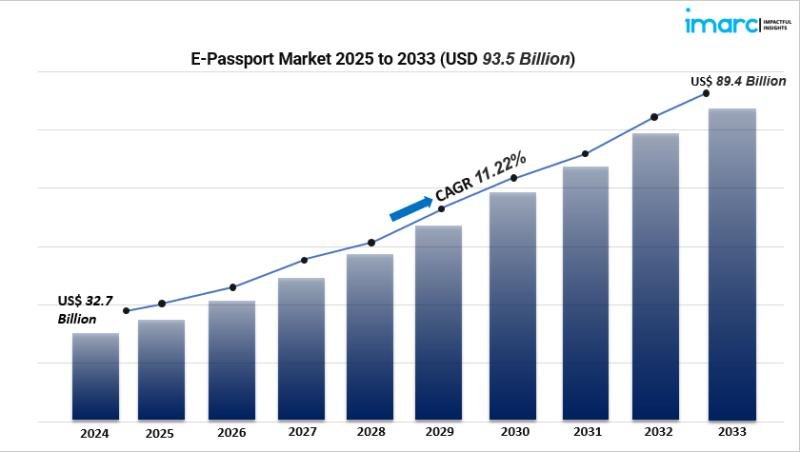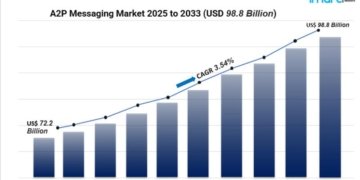Market Overview
The global e-passport market reached USD 32.7 Billion in 2024 and is projected to climb to USD 89.4 Billion by 2033 at an 11.22% CAGR (2025-2033). Growth is propelled by expanding airport infrastructure, rising international travel, rapid improvements in biometrics (RFID, facial/iris, encryption), and the public sector’s broader push toward digital identity and e-government services that streamline border control and enhance security.
Study Assumption Years
• Base Year: 2024
• Historical Year: 2019-2024
• Forecast Year: 2025-2033
E-Passport Market Key Takeaways
• Market size USD 32.7B (2024); forecast USD 89.4B (2033) at 11.22% CAGR (2025-2033).
• RFID leads by technology, favoured for secure, contactless, fast verification at checkpoints.
• Security stack: BAC, PACE, SAC, and EAC underpin encrypted, standards-based access and data exchange.
• Applications: Leisure travel currently dominates over business travel.
• Regional leader: Europe holds the largest share, reflecting early adoption and harmonized standards.
• Report scope spans global, regional, and country-level forecasts across Technology, Security, Application, and Region.
Market Growth Factors
1) Advancing biometric & chip technologies
Ongoing advancements in biometric technology and secure microcontroller design are key to the growth of e-passports. The leading RFID system allows for quick, contactless data transfer between passport chips and authorized readers, which speeds up processing times for travelers while ensuring that personal data remains encrypted both at rest and during transmission. When combined with on-chip storage of facial, fingerprint, or iris templates, authorities can achieve higher accuracy in matching identities and provide robust, tamper-proof identity verification. These features can be efficiently scaled across border e-gates and kiosks without the need for extensive back-office overhauls, making upgrades more affordable for governments looking to modernize their border systems. As encryption technologies and secure components continue to advance, countries can implement improved certificates and key management processes without interrupting the traveler experience-further solidifying RFID’s dominance and encouraging investment in compatible chipsets, readers, and middleware. Together, these technological improvements support the market’s growth trajectory from USD 32.7 billion to 89.4 billion by 2033, enhancing both security and processing efficiency.
2) Seamless travel & airport infrastructure upgrades
Airports around the globe are ramping up their investment in automation to keep pace with the ongoing surge in international travel. E-passports are at the heart of this shift, allowing for self-service kiosks and automated border e-gates that quickly verify chip data and biometrics, significantly reducing wait times and minimizing human error while ensuring consistent identity checks. This leads to a more seamless and quicker journey for passengers, allowing officers to focus on more critical screening tasks and increasing terminal capacity without needing a large staff. Since e-passports integrate smoothly with existing border systems and standards, authorities can gradually roll out additional lanes, expanding their reach as infrastructure develops. This dynamic-growing travel numbers, upgraded terminals, and standardized digital IDs-creates a positive feedback loop: enhanced experiences drive more people to adopt these technologies, and as adoption rises, it justifies the need for more lanes and system upgrades, supporting ongoing investments in hardware, software, and services through the forecast period from 2025 to 2033.
3) Policy alignment, interoperability & e-government momentum
Governments are ramping up their digitization efforts, speeding up the issuance of e-passports as part of a larger push for electronic identification systems. With standardized security measures like BAC, PACE, SAC, and EAC in place, we can ensure secure, encrypted connections between chips and readers, which allows for safe cross-border verification and information sharing. As agencies look for credentials that can be used worldwide, e-passports seamlessly fit into existing regulations and travel agreements. Meanwhile, government ministries are aligning passport upgrades with other services such as e-visas, pre-clearance, and digital travel credentials, which helps streamline procurement and maintain budget stability. This alignment of policy and technology not only minimizes the risk of fraud but also enhances services for citizens while safeguarding their privacy through cryptography and access controls. As more countries standardize their specifications and introduce next-generation passport booklets, the ecosystem of vendors grows, costs decrease, and adoption rates rise-bolstering Europe’s leadership and facilitating global expansion through 2033.
Request for a sample copy of this report: https://www.imarcgroup.com/e-passport-market/requestsample
Market Segmentation
IMARC categorizes the market by Technology, Security, Application, and Region. All segments and sub-segments below are listed exactly as presented.
Breakup by Technology
• Radio Frequency Identification (RFID): Contactless chip-reader communication enables quick, secure data exchange; supports encrypted storage of biometrics for fast verification at e-gates.
• Biometric: Uses facial, fingerprint, or iris templates embedded on the chip to strengthen identity assurance and reduce fraud across automated border controls.
Breakup by Security
• Basic Access Control: Foundational mechanism leveraging MRZ-derived keys to protect chip data and manage initial reader access.
• Password Authenticated Connection Establishment: Establishes a mutually authenticated, confidential session between chip and reader for secure exchanges.
• Supplemental Access Control: Adds stronger cryptographic access to sensitive data groups to mitigate skimming and eavesdropping risks.
• Extended Access Control: Governs controlled access to high-sensitivity biometrics, enabling tiered permissions for authorized authorities.
Breakup by Application
• Leisure Travel: Dominant usage; accelerates tourist flows through automated checks and self-service kiosks for faster, more convenient border crossings.
• Business Travel: Serves frequent travellers needing reliable, quick processing to minimize dwell times and enhance productivity.
Breakup by Region
• North America (United States, Canada)
• Asia Pacific (China, Japan, India, South Korea, Australia, Indonesia, Others)
• Europe (Germany, France, United Kingdom, Italy, Spain, Russia, Others)
• Latin America (Brazil, Mexico, Others)
• Middle East and Africa
Regional Insights
Europe is currently leading the way in the e-passport market. This leadership comes from being early adopters, having standardized practices, and rolling out automated border control systems that utilize RFID and cutting-edge security measures-making travel smoother and ensuring strong identity verification throughout the Schengen area and beyond.
Recent Developments & News
Recent updates on the topic focus more on technological advancements and adoption milestones rather than outside news: RFID continues to be the top technology for e-passports; leisure travel is the biggest use case; and Europe holds the largest regional market share. Security frameworks like BAC, PACE, SAC, and EAC are highlighted as crucial components for secure, interoperable verification at automated border checkpoints, bolstering modernization efforts at airports around the globe.
Key Players
• 4G Identity Solutions
• BioEnable Technologies
• CardLogix Corporation
• DERMALOG Identification Systems GmbH
• EKEMP
• Entrust Corporation
• ID Smart Cards
• IN Groupe
• Pentacomp
• Semlex Europe S.A.
• Thales Group
• Veridos GmbH
Ask Analyst for Customization: https://www.imarcgroup.com/request?type=report&id=6000&flag=C
If you require any specific information that is not covered currently within the scope of the report, we will provide the same as a part of the customization.
Contact Us:
IMARC Group
134 N 4th St. Brooklyn, NY 11249, USA
Email: sales@imarcgroup.com
Tel No: (+1-201971-6302)
About Us:
IMARC Group is a global management consulting firm that helps the world’s most ambitious changemakers to create a lasting impact. The company provides a comprehensive suite of market entry and expansion services. IMARC offerings include a thorough market assessment, feasibility studies, company incorporation assistance, factory setup support, regulatory approvals and licensing navigation, branding, marketing and sales strategies, competitive landscape, and benchmarking analyses, pricing and cost research, and procurement research.
This release was published on openPR.



















